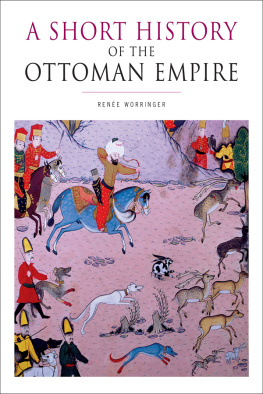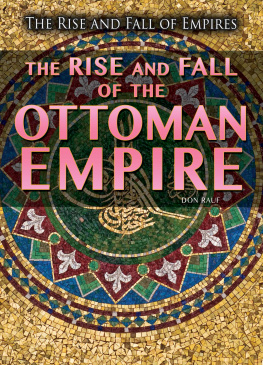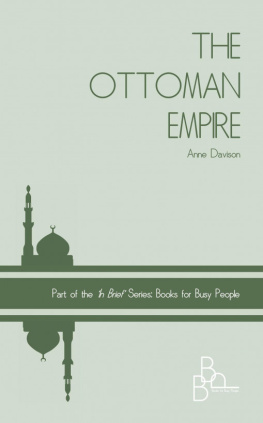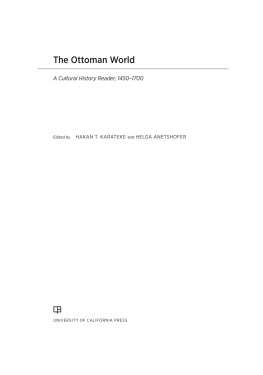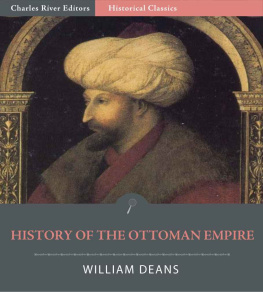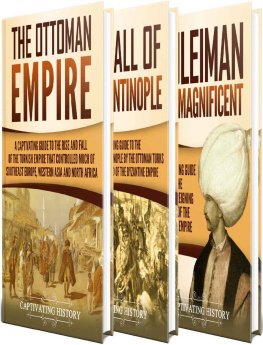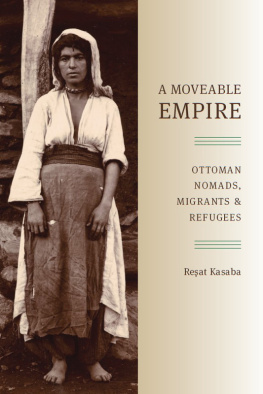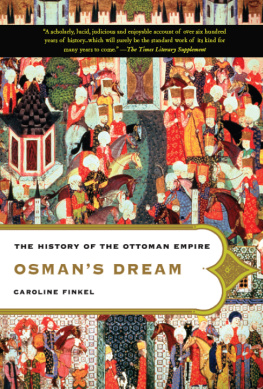Renée Worringer - A Short History of the Ottoman Empire
Here you can read online Renée Worringer - A Short History of the Ottoman Empire full text of the book (entire story) in english for free. Download pdf and epub, get meaning, cover and reviews about this ebook. year: 2021, publisher: University of Toronto Press, genre: Religion. Description of the work, (preface) as well as reviews are available. Best literature library LitArk.com created for fans of good reading and offers a wide selection of genres:
Romance novel
Science fiction
Adventure
Detective
Science
History
Home and family
Prose
Art
Politics
Computer
Non-fiction
Religion
Business
Children
Humor
Choose a favorite category and find really read worthwhile books. Enjoy immersion in the world of imagination, feel the emotions of the characters or learn something new for yourself, make an fascinating discovery.
- Book:A Short History of the Ottoman Empire
- Author:
- Publisher:University of Toronto Press
- Genre:
- Year:2021
- Rating:4 / 5
- Favourites:Add to favourites
- Your mark:
- 80
- 1
- 2
- 3
- 4
- 5
A Short History of the Ottoman Empire: summary, description and annotation
We offer to read an annotation, description, summary or preface (depends on what the author of the book "A Short History of the Ottoman Empire" wrote himself). If you haven't found the necessary information about the book — write in the comments, we will try to find it.
A Short History of the Ottoman Empire — read online for free the complete book (whole text) full work
Below is the text of the book, divided by pages. System saving the place of the last page read, allows you to conveniently read the book "A Short History of the Ottoman Empire" online for free, without having to search again every time where you left off. Put a bookmark, and you can go to the page where you finished reading at any time.
Font size:
Interval:
Bookmark:

A SHORT HISTORY OF THE OTTOMAN EMPIRE
HISTORY
OF THE
OTTOMAN
EMPIRE
RENE WORRINGER
UNIVERSITY OF TORONTO PRESS
Toronto Buffalo London
University of Toronto Press 2021
Toronto Buffalo London
utorontopress.com
Printed in Canada
ISBN 978-1-4426-0042-3 (cloth) ISBN 978-1-4426-0044-7 (EPUB)
ISBN 978-1-4426-0041-6 (paper) ISBN 978-1-4426-0043-0 (PDF)
All rights reserved. The use of any part of this publication reproduced, transmitted in any form or by any means, electronic, mechanical, photocopying, recording, or otherwise, or stored in a retrieval system, without prior written consent of the publisher or in the case of photocopying, a license from Access Copyright, the Canadian Copyright Licensing Agency is an infringement of the copyright law.
Library and Archives Canada Cataloguing in Publication
Title: A short history of the Ottoman Empire / Rene Worringer.
Names: Worringer, Rene, author.
Description: Includes bibliographical references and index.
Identifiers: Canadiana (print) 20200344315 | Canadiana (ebook) 20200344366 | ISBN 9781442600416 (softcover) | ISBN 9781442600423 (hardcover) | ISBN 9781442600447 (EPUB) | ISBN 9781442600430 (PDF)
Subjects: LCSH: Turkey History Ottoman Empire, 12881918.
Classification: LCC DR486 .W67 2021 | DDC 956/.015 dc23
We welcome comments and suggestions regarding any aspect of our publications please feel free to contact us at news@utorontopress.com or visit us at utorontopress.com.
Every effort has been made to contact copyright holders; in the event of an error or omission, please notify the publisher.
University of Toronto Press acknowledges the financial assistance to its publishing program of the Canada Council for the Arts and the Ontario Arts Council, an agency of the Government of Ontario.

The following abbreviations are commonly used in this book:
c. circa. Used in dates to mean they are approximate.
~ Used to suggest that the date is contentious or unknown.
b. date of birth
d. date of death
r. regnant dates
All dates are BCE (Before Common Era) or CE (Common Era).
The glossary, located at the end of this book, includes definitions of Ottoman Turkish, Turkish, and Arabic words, in English.
The writing of this Ottoman undergraduate textbook was a challenging yet enlightening undertaking for me from start to finish. As an Ottoman historian whose previous research focused on late Ottoman intellectual history, the development of nationalism in the empire among Turks and Arabs, and their desire to achieve modernity, I quickly recognized my shortcomings. I had crept into the field through several back doors from interest in the modern Middle East, in nave hopes of seeing a just resolution to the Palestinian-Israeli conflict; from an initial study of Arabic and Hebrew languages for that purpose, before realizing the need to look further back in time than the twentieth century to understand that conflict, which led me to Turkish and Ottoman languages and nineteenth-century history; from a year of living in Damascus, Syria; and from years spent living and working in Japan before grad school, which pulled my eventual research in Ottoman history to an exploration of Ottoman-Japanese relationships, both concrete and abstract. Writing this book has been my way of expanding my Ottoman horizons. A broader perspective opened up for me in Ottoman studies, thanks to the ever-increasing pool of scholarship by an ever-multiplying cadre of talented Ottomanists: from the history of early Ottoman conquests into the Balkans to the nature of the Danube River as both lifeblood of important eastern European cities and a marker of frontiers between imperial foes at different times; from the evolution of dynastic politics and the ruling Ottoman class to the changes in Ottoman war tactics and technology; from tolerant coexistence among ethnoreligious Ottoman peoples on the one hand to virulent nationalist divisions in the empire on the other.
Imperial rivalries, the differing methods of Ottoman provincial administration in far-flung border regions, the daily life of Ottoman subjects and the role of non-human animals in the empire, as often voiceless, yet significant agents of history, are just some of the many topics toward which I give a nod here. To the many Ottomanist colleagues and peers whose works I devoured in order to present to students clearer glimpses into the richness of the Ottoman Empires history, I am humbly grateful.
It is inevitable that there will be critics who will not like this book for not exploring this events significance or that persons contributions to Ottoman history in more detail, or for not sufficiently producing enough innovative themes or narratives. That is the risk of writing a general textbook. There are those who argue an introduction to the emergence of Islamic civilization and its various dynasties should not be included in an Ottoman history, for do European historians always include a summary of pre-modern Christendom before moving on to modern histories of European nation-states? Is it merely an Orientalist trope, an assumption that the Ottoman Empire can be understood as nothing other than another Muslim state that rose and fell?
I argue (and my experience with my students has reinforced this point, including their direct testimonies saying exactly this) that, for a textbook to be an effective tool for teaching an undergraduate course on the Ottoman Empire to students who typically have little to no knowledge of the Islamic Middle East, nor of Central Asia, an introduction to these regions and their diverse peoples and histories is an absolutely necessary first step to introducing them to the world of the Ottomans. And after all, the Ottomans learned who they were and eventually began to write about themselves as inheritors of traditions that harken back to earlier Islamic empires, in their chronicles, their record-keeping, and their relations with minorities. So in that spirit, students should learn who the Ottomans understood themselves to be.
In any case, if this textbook is not groundbreaking for the information it provides to Ottoman specialists, in my opinion it will still be a welcome addition to the field, as a comprehensive text introducing students to a rich and sometimes overlooked history of an empire that left an indelible mark on the world. European histories often omit the presence and actions of the Ottoman Empire in their narratives; my intention in this book for students is to replace that error with a story that incorporates the Ottoman Empire into its proper Eurasian context, as an empire at the crossroads of seas, continents, and cultures.
The list of those who enabled me in this endeavor must start with my editor at the University of Toronto Press, Natalie Fingerhut, who first asked me if I would be interested in such a project several years ago. Her constant enthusiasm, support, and feedback for my manuscript, especially when my overindulgence in maps and images pushed resources to the limit (!), motivated me to constantly rethink how to best captivate the undergraduate reading audience. Judith Earnshaws keen set of eyes to oversee the accompanying artwork has made the final result a visually stunning textbook that makes the narrative come alive. Former graduate students of mine, Haley Wilson and Anne Vermeyden were research assistants who assisted me in exploring the vast amount of sources and visual aids now available to the Ottomanist across period and region. Marie Puddister did an excellent job rendering specific maps for me, which was no easy task when trying to capture the expansions and contractions of often-contested Ottoman territory over time. My colleagues in the History Department at the University of Guelph, who have made my academic life richer from their knowledge and observations as well as from their friendship and the supportive environment they foster, generously read and commented on some of the early drafts of the first chapters, and their guidance was immeasurable. Sabbatical leave and a course release from the History Department moved the project along. I can also thank students in my Ottoman history courses at Guelph in 2017 and 2019/2020 who read and reviewed chapters of the manuscript. Their honest critiques of the material as undergraduates allowed my test drive of it to sometimes confirm what I thought needed to be in and, at other times, to be excised from the final textbook. The College of Arts generously provided travel funds for me to attend a conference at the University of Zadar in Croatia in 2016 entitled Negotiating Limits between Early Modern Sovereignties: Venetian Dalmatia and Ottoman Bosnia FifteenthEighteenth Centuries. The willingness of Karen-edis Barzman and Palmira Brummett to allow me to engage with the many Italian and Croatian scholars in this setting and to enjoy a field trip to the actual physical border sites of the Venetian and Ottoman empires did more to educate me in the complexities of the Ottoman Balkans than I could have grasped otherwise.
Font size:
Interval:
Bookmark:
Similar books «A Short History of the Ottoman Empire»
Look at similar books to A Short History of the Ottoman Empire. We have selected literature similar in name and meaning in the hope of providing readers with more options to find new, interesting, not yet read works.
Discussion, reviews of the book A Short History of the Ottoman Empire and just readers' own opinions. Leave your comments, write what you think about the work, its meaning or the main characters. Specify what exactly you liked and what you didn't like, and why you think so.

